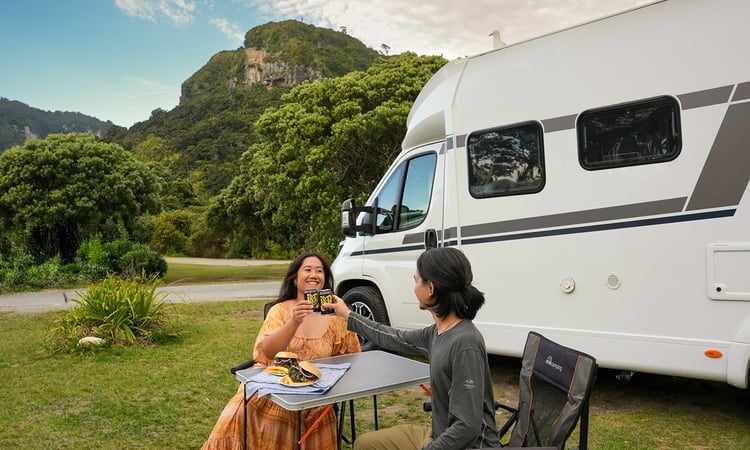
Every great New Zealand road trip begins with a few exciting questions. Which motorhome will be your home on the road? Will you chase the endless summer days or the crisp colours of autumn? Which winding roads will you follow to mountain peaks and quiet coastlines? And where will you park up for the night?
This step-by-step guide makes planning simple. We'll walk you through the key choices so you can create a trip that’s uniquely yours. By the time you’re finished reading, you’ll be ready to start planning the ultimate New Zealand campervan road trip.
Step 1: Choose your season. When is the best time to travel in New Zealand?
Before you start tracing your finger along road maps or thinking about must-see stops, the very first decision in planning a New Zealand motorhome trip is deciding when to go. The season you travel in will shape almost every part of your experience — from the number of daylight hours you’ll have, to how busy the roads and campgrounds feel, and even how far your budget stretches.
Summer: December – February
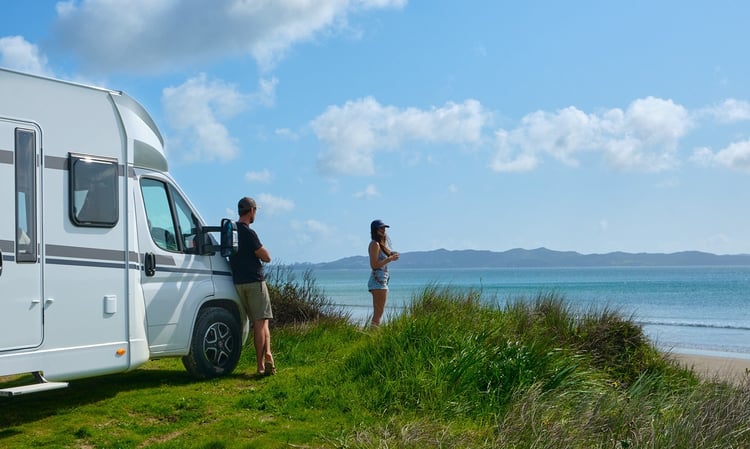
Long, warm days and plenty of sunshine make summer the ideal time for a campervan road trip for sun-chasing travellers. The flip side is that it’s also the busiest season, with higher rental rates and campgrounds that book up quickly.
Best suited to travellers who love the energy of peak season; think beach days, lake swims, alfresco dining, and long evenings spent outdoors. It’s perfect for families on school holidays or anyone wanting that iconic Kiwi summer road trip vibe.
Top tip: Here's a tip you won't read anywhere else. The first half of December is still relatively quiet for New Zealand tourism. The locals and the Australians are still at work and there are far fewer international visitors compared to November. You can often find a 2-3 week window in December where the campsites are quiet and you can find some great deals on motorhome rental rates.
Autumn: March – May
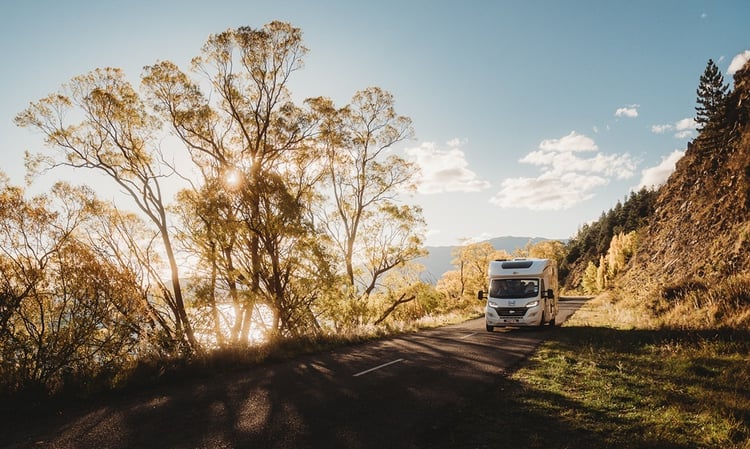
Clear, settled weather and spectacular red and gold foliage make autumn a rewarding time to explore. As a shoulder season, it offers a quieter, more relaxed way to experience New Zealand. Plus, you can expect fewer crowds on the roads and at popular sites.
Best suited to travellers who enjoy crisp mornings, scenic walks, and long lunches among the vines. It’s a favourite for photographers, foodies, and anyone who values space to explore without the summer rush.
Top tip: As autumn days grow shorter, aim to reach your campsite before dark. Setting up in daylight makes things easier and gives you time to settle in, cook dinner and enjoy the golden hour views from your motorhome.
Winter: June – August
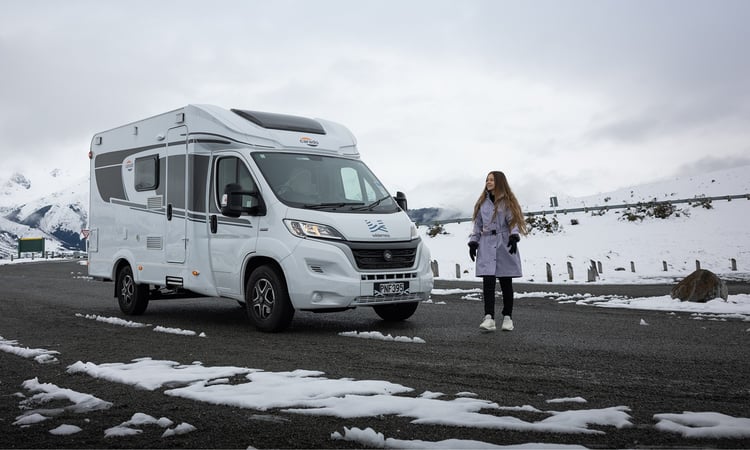
Crisp days, snow-capped peaks, and quieter roads give winter in New Zealand its own special feel. Rental rates are at their lowest, making this the most budget-friendly time to travel. Stargazing, scenic drives, and cosy nights in your motorhome are all part of the winter experience.
Best suited to travellers who love snowy mountain scenery, soaking in hot pools, and winding along quiet, crowd-free roads. It’s perfect for those who enjoy slow mornings and snug evenings parked up somewhere scenic.
Top tip: Be sure to choose a motorhome equipped with good heating and insulation so you’ll be warm and toasty whatever the weather. Read more about travelling New Zealand by campervan in winter.
Spring: September – November
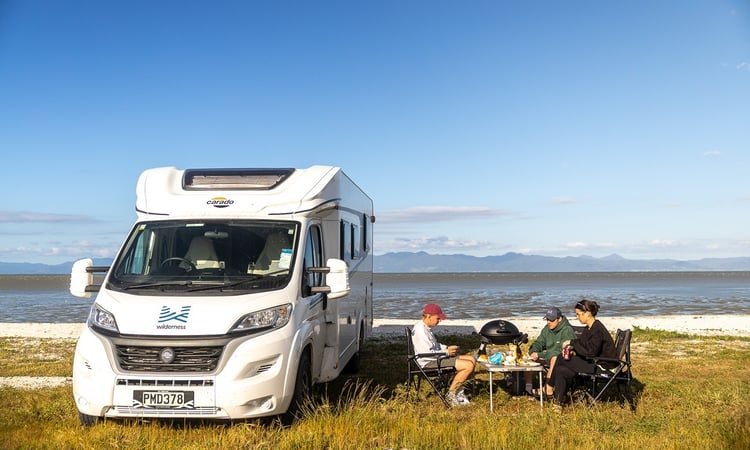
Fresh greenery, blossom-lined roads, and lambs in the paddocks create a colourful backdrop for spring travel. With longer days and moderate prices, the months of September to November offer a combination of comfortable weather and fewer visitors than peak summer.
Best suited to travellers who enjoy mild weather, blooming gardens, and wildlife encounters. It’s a wonderful time for walkers, nature lovers, and anyone who wants to experience New Zealand at its most vibrant and alive.
Top tip: Allow time for seasonal highlights, such as blossom festivals, garden trails, or spotting baby seals on the Kaikōura coast. Take the scenic route whenever you can — spring drives are filled with wildflowers, fruit blossoms, and newborn animals in the fields.

Winter turned out to be the most magical time to explore the South Island. The roads were quiet, the scenery was incredible, and every stop felt calm and intimate. Evenings were our favourite — soaking in hot pools, cooking dinner in the motorhome, and just enjoying the sense of slowing down. It was easily the most romantic trip we’ve ever taken.
Step 2: Decide on your trip length. How long should you hire a motorhome for?
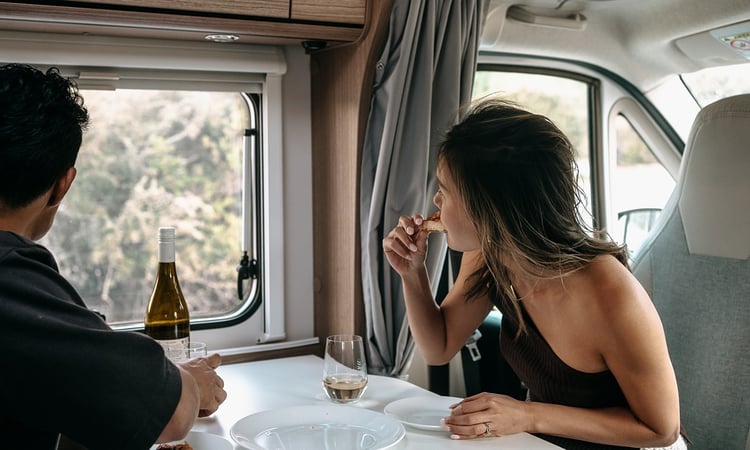
Now that you’ve thought about when to take your campervan road trip in New Zealand, it’s time to decide how long to hire a motorhome for. Getting this right is important — it can mean the difference between a relaxed and refreshing holiday and one that feels like you’ve spent more time driving than discovering.
A key factor to keep in mind is New Zealand's driving times. Distances may look short on a map, but winding roads, mountain passes, and frequent photo stops mean travel often takes longer than expected. And of course, unexpected hidden gems along the way can mean that a three-hour drive on paper can easily take most of the day.
So, how much time should you allow? Here’s a guide to what you can realistically see and do with different trip lengths. For more detailed information about what you can see on each island in your time frame, check out our motorhome road trip itineraries. They’re packed with valuable information on how many days you’ll need to get the most out of your trip.
10 – 14 days
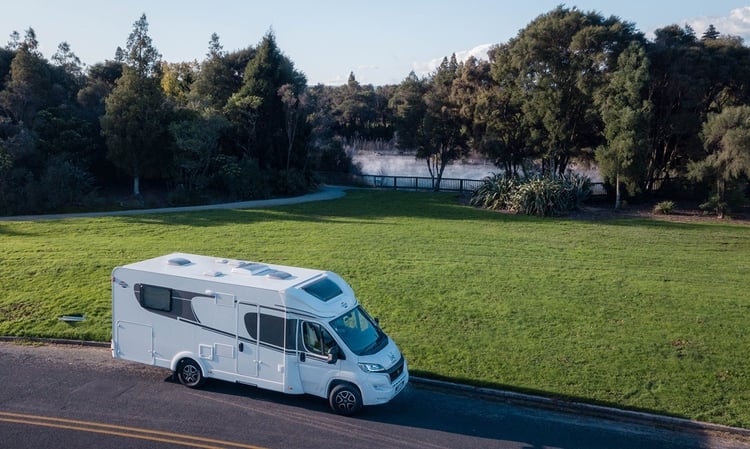
This is the sweet spot for exploring one or two regions of your chosen single island without feeling too rushed.
If you choose the North Island, you’ll have time to cover cultural hubs like Rotorua and Wellington alongside rolling farmland, ancient kauri forests and wide, open beaches.
In the South Island, you could comfortably take in highlights such as The Catlins, Fiordland and the West Coast glaciers.
Two weeks might not sound long, but with the right route it’s enough for a rewarding trip — as long as you resist the temptation to squeeze in both islands. Trying to do that in under two weeks means too much time behind the wheel and not enough time enjoying the places you came to see.
3 weeks
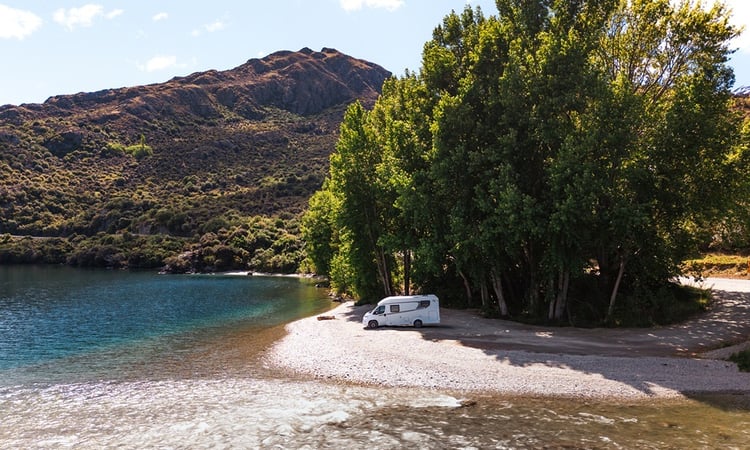
Three weeks gives you breathing space and opens up the option of exploring both islands, which many travellers find is the ideal timeframe for a first full motorhome holiday in New Zealand.
This is where motorhome touring is very different from renting a car. Unlike car rental companies, which are found in most cities, around 90% of motorhome rental operators are based in Auckland and Christchurch, with a handful in Queenstown. This means you must plan to pick up and return your vehicle at one of these hubs.
To make the most of your time, a one-way rental is the best strategy. You can pick up in Auckland, explore both islands — taking your motorhome with you on the Cook Strait ferry—and drop off in Christchurch. This is highly recommended as it saves you from backtracking, which would waste precious holiday time.
4 weeks or more
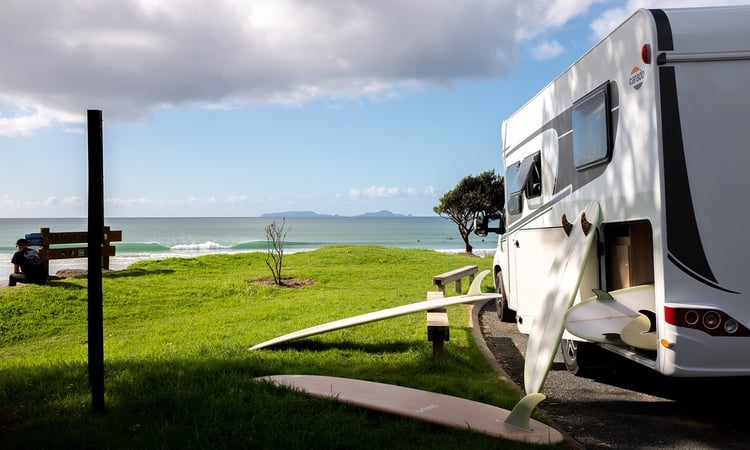
If you have the time, this is the most immersive way to experience New Zealand.
A month or more allows you to go well beyond the headline attractions and discover smaller towns, remote coastlines, and tucked-away walks you’d otherwise miss.
It also means you can build a rhythm of travel that feels unhurried, allowing you to spend several nights in one campground before moving on. Many long-term motorhome travellers find that this slower approach is what turns a holiday into a truly memorable experience.
With four weeks or more, you can still see both islands, but you’ll also have the freedom to take spontaneous detours or stay a little longer in a special spot.

Mobile apps such as CamperMate NZ, Rankers Camping & Wiki Camps are a great resource, especially if you’re travelling for weeks at a time. They can help you find campgrounds, supermarkets, dump stations, and much more.
I highly recommend downloading at least one before your first motorhome trip.
Step 3: Pick your playground. North Island vs South Island?
Once you’ve decided when to travel and how long to hire a motorhome for, the next big choice is where to go: North Island, South Island, or a combination of both.
Each island offers a different flavour of New Zealand, and the right option for you depends on the kind of motorhoming experiences you’re most excited about.
North Island highlights
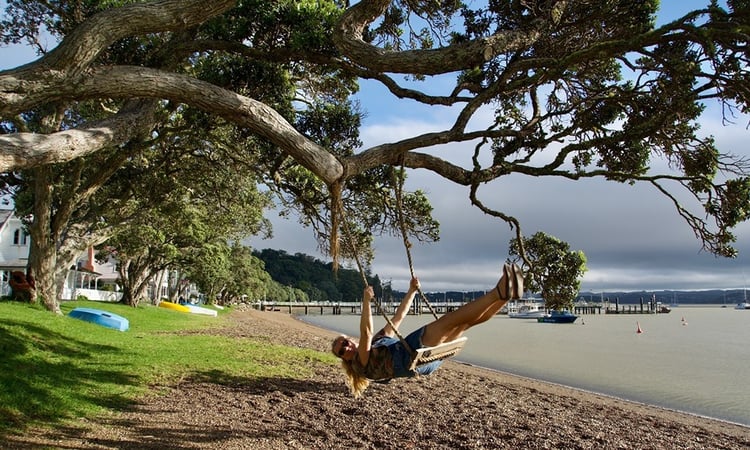
The North Island combines culture, geothermal activity, and stunning coastlines with vibrant cities and rolling countryside. Here are some of the top spots worth adding to your New Zealand road trip planner:
-
Bay of Islands – Ideal for motorhome travellers who love a relaxed coastal vibe. This beautiful part of New Zealand offers some stunning beachfront campsites where you can park up just steps from the water. A great spot to slow down for a few days.
-
Auckland – New Zealand’s largest city, with a mix of harbours, islands, and a dynamic food and arts scene. As one of the main motorhome pickup hubs, Auckland is a natural starting point for your road trip. Stock up on supplies here, explore the city, then hit the road north or south.
-
Rotorua – A favourite for campervan travellers looking for an easy road trip from Auckland, Rotorua is famous for bubbling mud pools, steaming geysers, and rich Māori culture. It’s one of the best places to experience a traditional hāngi meal or cultural performance. You’ll also find plenty of excellent campgrounds and holiday parks.
-
Tongariro National Park – Home to volcanic peaks and the world-renowned Tongariro Alpine Crossing. The dramatic landscapes here have starred in films such as Lord of The Rings and are a must for keen hikers. The Whakapapa Holiday Park is a popular campground and can help arrange a shuttle if you’re keen to do the crossing.
-
Martinborough – A popular stop for campervan travellers, Martinborough is well-equipped with plenty of great campsites and motorhome-friendly facilities. This boutique wine region is known for its pinot noir and easy-to-navigate cellar doors. It’s a relaxed stop where you can cycle between vineyards and sample some of New Zealand’s best wines.
-
Wellington – A compact, easy-to-navigate city for motorhome travellers, with good freedom camping options. Wellington is the gateway to the South Island, with the ferry terminals located just a few minutes from the heart of the city.
South Island highlights
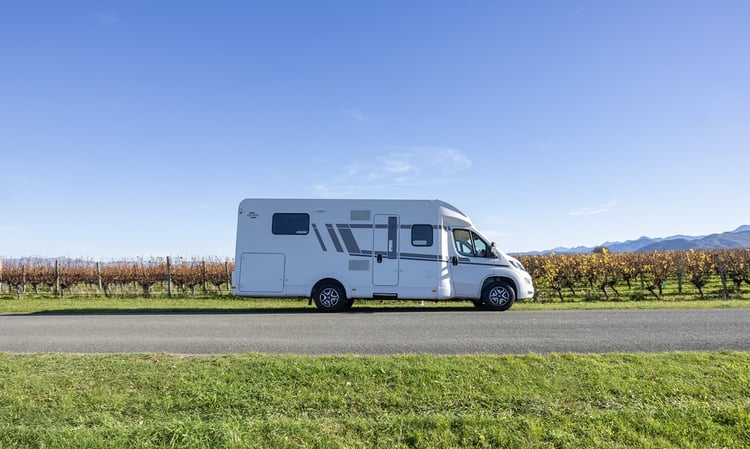
The South Island is renowned for its dramatic landscapes, ranging from alpine peaks to rugged coastlines. Here are some of its most memorable stops:
-
Marlborough – A favourite first stop for motorhomers arriving by ferry in Picton. The flat roads, sunny climate, and vineyard-lined routes make it a relaxing spot to ease into your South Island road trip. You’ll find excellent holiday parks and freedom camping options.
-
Kaikōura – Just a few hours’ drive from Christchurch, Kaikōura is an easy and rewarding stop for motorhome travellers. It’s well set up with beachside holiday parks and self-contained camping options close to town. Once parked, you can explore on foot — with whale watching tours, seal colonies, and local seafood all within easy reach.
-
Christchurch – As one of the South Island’s main motorhome rental hubs, Christchurch makes a natural start or finish point for your road trip. The city has well-equipped holiday parks and easy routes in and out, whether you’re heading west toward Arthur’s Pass or south through Canterbury. Stock up on supplies, take a day to explore the rebuilt city centre, and then hit the road.
-
West Coast glaciers – Franz Josef and Fox Glaciers are ideal for motorhome travellers looking for dramatic scenery and unique walks. You can park up just minutes from the glacier trails, and the rainforest surrounds make for a truly atmospheric overnight stay. The drive here, especially via Haast Pass or Arthur’s Pass, is as much a highlight as the glaciers themselves.
-
The Catlins – Remote and rugged, The Catlins is a dream destination for compact motorhome travellers who enjoy wild coastlines, waterfalls, and quiet roads. It’s made for slow travel, featuring a handful of well-placed Department of Conservation (DOC) campsites and holiday parks that let you stay close to nature without rushing. However, the Catlins has very narrow roads to access many of the beaches, with nowhere to turn around if you get it wrong and need to backtrack. We only recommend this destination to compact motorhomes.
Best of both worlds: North and South
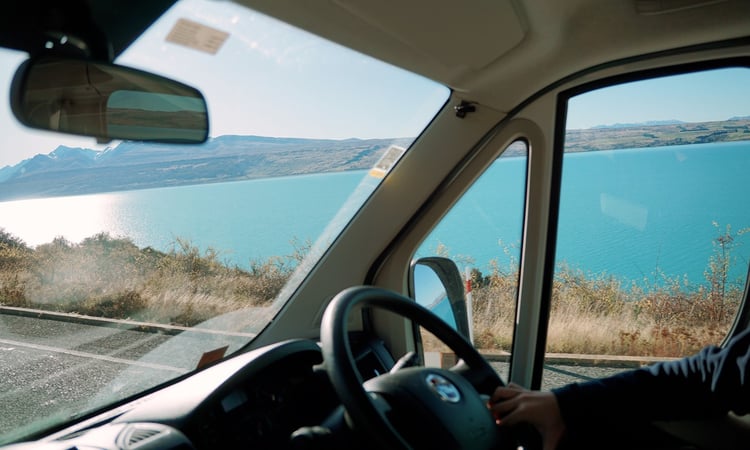
If you’ve got three weeks or more, you don’t have to choose between the islands; you can enjoy the contrasts of both in one trip.
The Cook Strait ferry links Wellington in the North with Picton in the South, and it couldn’t be easier to travel on the ferry with your motorhome. Simply drive on, relax for the three-hour sailing, then roll off the other side ready for the next stage of your adventure. As of October 2025 and until 2029, ferry capacity is down 30%. We recommend booking your trip well in advance, especially during peak season, to ensure you get the travel days and times you want.
For more inspiration, check out our guide to the best places to visit in NZ by campervan.

It’s worth bearing in mind that everyday items can be considerably more expensive in remote areas of the South Island – especially on the West Coast. I would recommend stocking up on food and drink at the main centres before heading to places like Franz Josef, or you may get a shock at the prices!
Step 4: Set your budget. How much does a NZ motorhome trip cost?
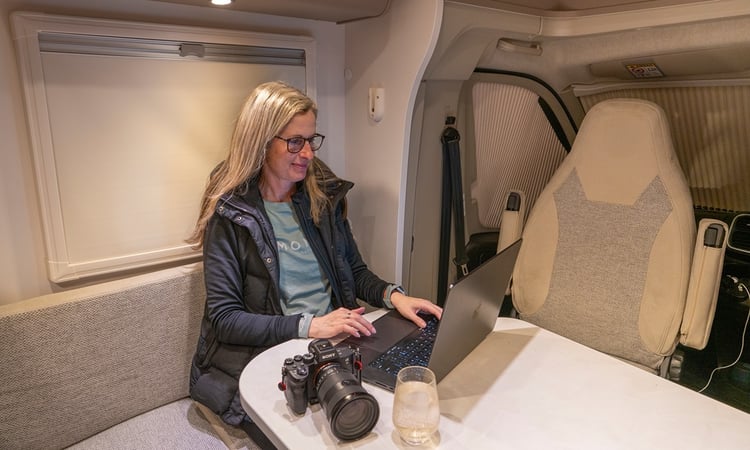
One of the best things about travelling by motorhome is how flexible your budget can be. You can keep it simple with low-cost campsites and home-cooked meals, or treat yourself to full-facility holiday parks, regular dining out, and guided tours.
The key is knowing roughly what to expect. That way, you can shape your trip to match your travel style without worrying about unexpected costs.
For a comfortable two-week holiday, most travellers spend between NZD $5,000 and $7,000 for two people.
This range covers everything from your motorhome rental to food, fuel, and campgrounds. Naturally, the exact figure depends on the time of year you travel, the size of motorhome you hire, and how many paid activities you include, but this ballpark gives you a solid starting point.
Here’s how that budget typically breaks down:
Motorhome rental
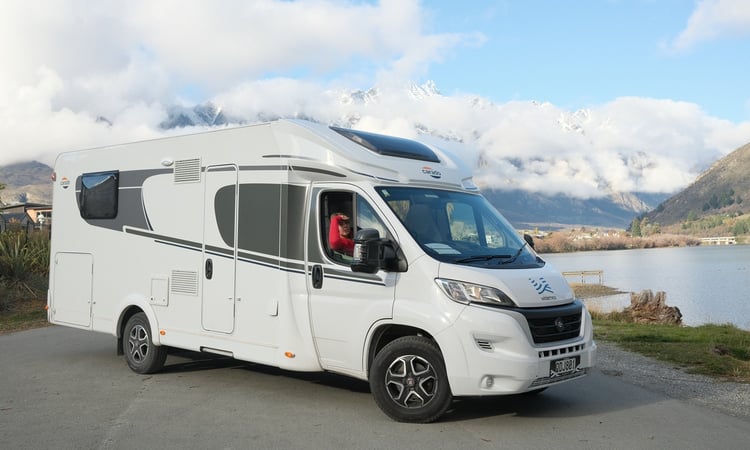
Your motorhome hire will nearly always be the biggest chunk of your budget. Daily hire rates range from about NZD 100/day up to NZD 900+/day depending on model, season, and extras.
Of course, the exact cost of hiring a motorhome will depend heavily on season, vehicle size, amenities and rental operator. Here are a few considerations to factor in:
-
Seasonality: Rental prices are highest in summer (December–February) when demand peaks, especially around school holidays. Autumn and spring offer better value, and winter tends to be the most budget-friendly time to hire, often with bonus nights or reduced rates for longer trips.
-
Vehicle size, age, and condition: Newer motorhomes with modern layouts and high-end features often sit at the premium end of the price range. At the other end of the budget are often older vehicles or basic campervans that have fewer features. While these older motorhomes can be a good way to save money, there are trade-offs: they may be less reliable, less insulated, and less comfortable, particularly in colder months or on longer journeys.
-
Vehicle features: Amenities such as ensuite bathrooms, central heating, solar panels, larger fridges, automatic transmission, and USB charging can increase both comfort and cost. Self-contained certification is essential if you plan to stay at DOC sites or freedom camp — and not all budget vehicles meet this standard.
-
Length of hire: This works very differently from car rentals. Rather than just offering discounts for longer bookings, motorhome operators often have minimum hire periods. During the busy peak season, this might be 10 days. This means even if your trip is only seven days, you may have to pay for the 10-day minimum. In the off-season, this is often shorter, such as a 5-day minimum. This policy exists because motorhomes require significant preparation and turnaround time between each hire, which isn't viable for very short-term rentals.
-
Liability reduction (insurance cover): Your daily rental rate includes basic insurance. Because motorhomes are very expensive to buy (often $100,000 or more) and repair in New Zealand, rental operators carry more risk than car rental companies. To balance this risk, the included insurance has a high "excess" (the amount you are liable for if there's damage), typically $5,000–$7,500. This is often double what you'd expect for a rental car.
You can choose to pay extra for a "liability reduction option" to lower this high excess. To get the excess down to $0, it generally costs $50–$70 per day. Cheaper options are also available that just reduce the excess instead of eliminating it. If you choose to accept some or all of the liability by taking a liability reduction option with an excess greater than zero, the rental operator may want to collect a bond from you.
Learn more about motorhome rental insurance.
On-road costs
Fuel, road user charges, and ferry tickets all add to your travel budget. While they’re not your biggest expense, they’re important to factor in.
-
You'll need to budget for two key running costs: fuel and Road User Charges (RUC). Diesel prices fluctuate, but as a guide, expect to pay around $2.80–$3.20 per litre. Since most rental motorhomes are diesel, you will also need to pay the RUC. This government fee is calculated based on the distance you travel—at approximately $8.40 per 100 km—and is typically added to your final rental cost.
-
If crossing between the North and South Islands, the ferry costs approximately $300–$700 one way for two people and a motorhome, depending on the time of year.
Living expenses
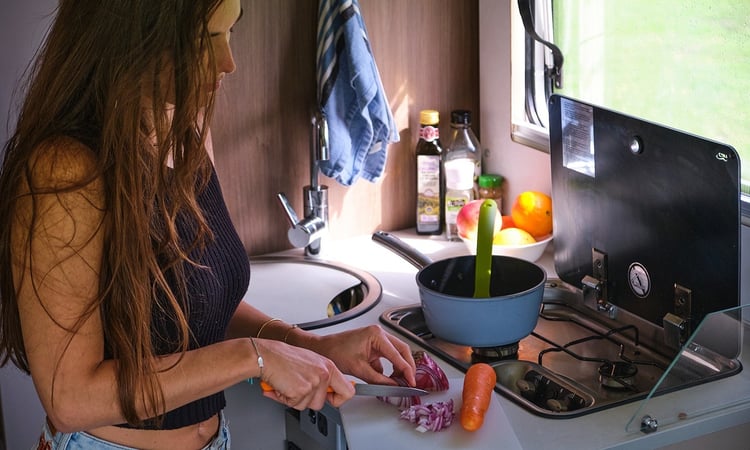
Everyday costs, such as campgrounds, food, and activities, will vary depending on your style of travel. This gives you the most flexibility to save or splurge.
-
Holiday parks cost around $50–$80 per night for two people.
-
DOC sites are much cheaper at $10–$20 per person; freedom camping in designated areas is also low-cost (and sometimes free).
-
Groceries for two cost an average of $150–$200 per week, with restaurant meals costing around $35 - $50 per person.
-
Paid attractions range widely, from $40–$60 per person for geothermal parks to $150–$200 for iconic experiences like a boat cruise or guided tour.
The beauty of travelling by motorhome is the flexibility to adjust your costs as you go. Cook meals onboard and make the most of free or low-cost campsites, and you can keep your spending on the lower end. Stay in full-facility holiday parks every night and book guided tours along the way, and you’ll be closer to the higher end.
Looking for smart strategies to get the most from your motorhome trip budget? Take a look at our insider tips for saving money on campervan rental costs in New Zealand.
Ready to start planning your New Zealand motorhome trip?
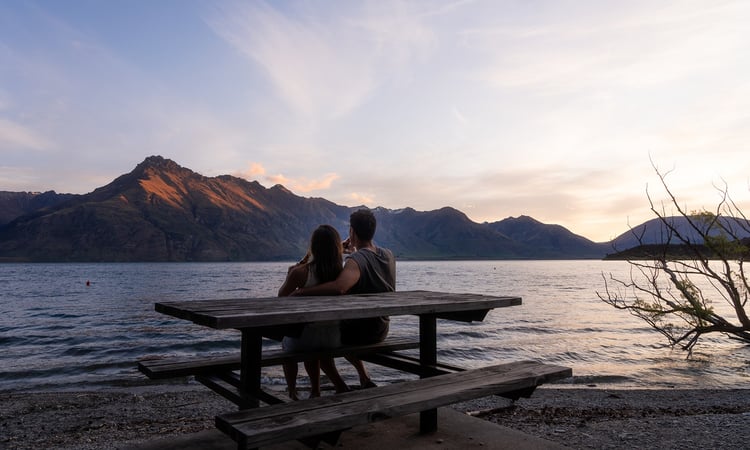
Planning a motorhome holiday in New Zealand involves a fair few decisions, but once you’ve tackled the four essentials — season, trip length, island choice, and budget — you’re well on your way.
With those decisions made, the rest of your planning becomes much easier and a lot more fun.
Whether you’re dreaming of summer days at the beach, winter nights under snow-capped peaks, or a spring or autumn trip surrounded by a landscape of changing colour, the right combination of timing, pace, and budget will shape a motorhome itinerary that works for you.
To make things even easier, check out our ready-made New Zealand motorhome itineraries.
-
No. If you have a full driver’s licence in English, you can drive a motorhome in New Zealand. If your licence is in another language, you’ll need either an official translation or an International Driving Permit. Most rental motorhomes are under 6,000kg, so a standard licence is fine.
-
Yes — you’ll find a good mix of holiday parks, Department of Conservation (DOC) campsites, and designated freedom camping spots throughout the country. Use apps like CamperMate or Rankers to check what’s available nearby, and always follow local signs and rules.
-
It depends on what kind of trip you want. If you love the sun, then a summer (December–February) road trip is best for you, but it’s the busiest and most expensive. Spring (September–November) and autumn (March–May) are shoulder seasons with fewer crowds and good value. Winter (June–August) is the quietest and cheapest time to travel, with the bonus of snow-capped scenery.
-
No — freedom camping is only allowed in designated areas. Some councils have restrictions, and you must stay in a self-contained motorhome to use most freedom camping sites. Always check local signs, follow the rules, and leave no trace so that these spots remain open to travellers. Read more in our essential guide to freedom camping in New Zealand.


